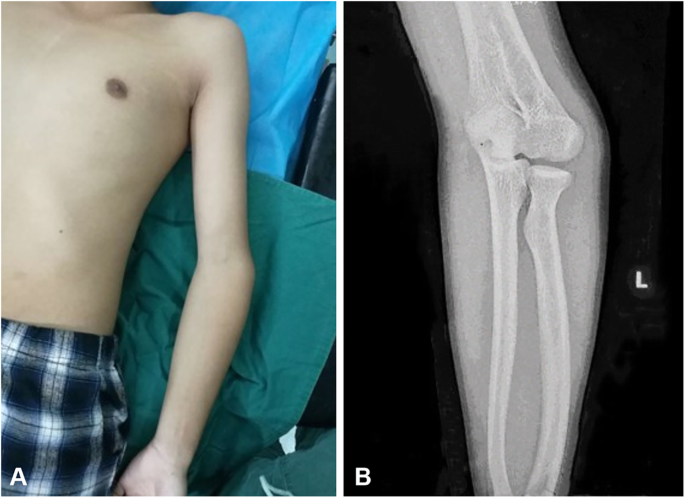Foot muscle strengthening exercises
Table of Contents
What are foot strengthening exercises?
- Foot strengthening exercises are a great way to make the foot powerful enough to take all the body weight easily & perform all the activities easily and decrease the risk of foot-related injury & also have many health benefits.
- If the patient is performing this exercise regularly this also improves stamina as well as fitness level.
Why do foot exercises matter?
- Every person experiences foot or ankle pain at some point. Keeping the feet strong can help the patient to alleviate this soreness help decrease foot & ankle pain, as well as improve overall health & flexibility.
- Regularly exercising & stretching the feet as well as ankles can help to ensure that the muscles are providing the best support.
- These exercises may also improve the range of motion in the feet, & keep the patient active for as long as possible.
- Most foot exercises are simple & require no complicated equipment to complete the exercise. Individuals may perform them at home or in the gym as part of a regular exercise routine.
- Foot Exercises that improve foot flexibility as well as mobility & help limber up the feet may decrease the chance of getting hurt.
- Slow & gentle stretches will improve the range of motion. These exercises will allow the muscles to provide better support & protection for the foot as a whole.
- The patient can perform these gentle stretching & strengthening exercises 3 days per week or as often as every day to improve the range of motion as well as strength for lifelong foot health and vitality.
- If the feet & ankles pain a lot, if the patient has any injuries, or if the patient has arthritis or diabetes, be sure to check with the physician or physical therapist before start performing any of these exercises. Depending on the condition, the physician may add other exercises or take away some of the ones listed here.
Health benefits of foot strengthening exercise
- Keeping the feet strong and flexible as well.
- This exercise Help to decrease foot & ankle pain,
- Helps to decrease muscle soreness,
- Keep the patient active,
- Reduce the chance of getting hurt.
- Improve the overall foot health
- Improve arch of the foot – important for flat foot
- Critical in saving ourselves from falling.
Different types of exercise strengthen the foot muscles
Toe raise, point, as well as curl
- How to do this strengthening exercise:
- This 3-part exercise will begin to get the toes & feet moving.
- For this exercise, the patient has to Sit in a straight-backed chair with the feet flat on the floor.
- The toes should be flat on the ground & elevate the heels until only the balls of the feet, as well as the toes, touch the ground. Hold for five to seven seconds.
- Point the toes so that only the ends of the big & 2nd toes touch the ground. Hold for 5 seconds.
- Keep the heel off the ground & roll the toes under so that the tops of the toes touch the ground. Hold for 5 seconds.
- Repeat each position 10 to 15 times in one session. Do two sessions in a day.
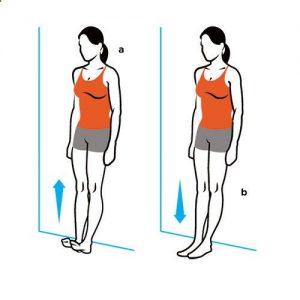
Toe splay

- How to do this exercise:
- This exercise will help the patient to gain control over the toe muscles.
- For this exercise, the patient has to sit in the back-supported chair with the foot resting on the floor.
- Spread all the toes apart as far as comfortable. Hold for seven seconds in one repetition. Do ten repetitions in one session. Do two set with two sessions in a day.
- The patient can make this exercise difficult by looping the resistance band around the toes of each foot.
Toe extension
- How to do this strengthening exercise:
- This exercise is good to prevent or even treat plantar fasciitis, which causes heel pain.
- For this exercise, a patient has to sit in the back-supported chair with the foot resting on the floor.
- Pick the right foot up & place it on the left thigh.
- Hold the toes with one hand as well as pull them up toward the ankle until the patient feels a stretch along the bottom of the foot & in the heel cord.
- Massage the arch of the foot with the right hand while this exercise. Hold for 10 to 15 seconds.
- Repeat ten times on both feet per session. Do two sessions in a day.
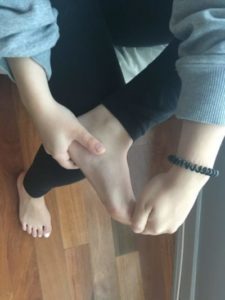
Toe curls
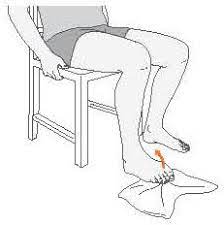
- How to do this exercise:
- Toe curls will strengthen the muscles on the upper part of the feet and toes as well.
- For this exercise, the patient has to sit in the back-supported chair with the foot resting on the floor.
- Take one napkin on the floor in front of you so the short end is at the feet.
- Place the toes of one foot on the end of the napkin, & scrunch the toes so you pull the napkin toward you.
- Repeat five times with each foot. The patient can add some difficulty to this exercise by placing a small weight (like a can of soup) on the far end of the napkin.
Marble pickup
- How to do this strengthening exercise:
- The marble pickup exercise will strengthen the muscles on the bottom of the feet & toes.
- For this exercise, the patient has to sit in the back-supported chair with the foot resting on the floor.
- Place 25 marbles & a small bowl on the floor in front of you.
- Pick up one marble at a time with the toes & place this in the bowl. Use one foot to pick up all 25 marbles.
- Repeat with the other foot.

Big-toe stretch

- How to do this strengthening exercise:
- Get good flexibility in the big toe with this 3-part stretch. This feels good after having the feet crammed in dress shoes all day.
- For this exercise, the patient has to sit in the back-supported chair with the foot resting on the floor.
- Pick the right foot up & place it on the left thigh.
- Gently use the hand to stretch the big toe up, down, & to the side away from the other toes. Hold the stretch in each direction for 5 seconds.
- Repeat 15 times in each direction.
- Repeat with the left foot as well.
Tennis ball roll
- How to do strengthening exercises:
- This exercise assists to treat Plantar fasciitis & arch pain. Rolling the hardball on the bottom foot.
- Rolling the bottom of the foot on the hardball may ease arch pain & treat plantar fasciitis.
- For this exercise, the patient has to sit in the back-supported chair with the foot resting on the floor.
- Place a tennis ball on the floor near the feet.
- Put the foot on top of a tennis ball & roll this around, massaging the bottom of the foot.
- Increase or decrease pressure as needed.
- Roll for three minutes on each foot.
- The patient can also use the frozen bottle of water if he does not have any tennis balls handy.
Sand walking

- How to do this sand walking strengthening exercise:
- Barefoot walking in the sand strengthens & stretches the feet as well as the toes & gives the best calf workout.
- Walking in sand is more useful to the muscles than walking on hard paths, so make sure the patient turns around before he has worn himself out.
Big Toe Press
- How to do this strengthening exercise:
- Press the big toe into the floor during lifting the other 4 toes.
- Hold each press for 6 seconds & perform 10–15 repetitions on each foot.
- Practice ten times in a set. Do three sets in a session. Perform two sessions in the day.
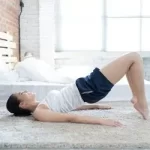
Leg Swings
- How to do this strengthening exercise:
- Perform this legs swings with a small amplitude to challenge the balance & ankle as well as hip stability.
- Stand on a single leg in bare feet & create the short foot posture.
- Swing the non-stance leg forward as well as backward 10 times.
- Without rest, swing the same leg left & right in front of the stance leg, also 10 times.
- Repeat this sequence without taking a rest, then repeat on the other leg.
Calf Raise to Big Toe Press

- How to do this strengthening exercise:
- To perform this exercise the patient has to stand on the edge of a stair barefoot.
- The heels drop below the level of a stair.
- Firstly the patient has to do a basic calf raise and then complete this by pressing the big toe. This will challenge the foot muscles.
- Feel free to hang on to something for balance.
- Do 10-15 repetitions in one session. Do two sessions in a day.
Heel Raises
- To begin with, this strengthening exercise may be performed at home as well as at the clinic, what a patient should do is stand near the wall or even a chair that the patient can balance against. Slowly raise the left foot back until the lower leg is at a 90-degree angle. Hold for ten seconds, and come back to the embarking position. Repeat five times with each leg in one session. Do two sessions in a day.

Ankle Rotations
- First of all, raise the foot about 20 inches off the floor. After that, with the toe upward, rotate the foot to the left & then back to the right. Hold for ten seconds then come back to the starting position. Repeat ten times for each leg in one session. Do three sessions in a day.
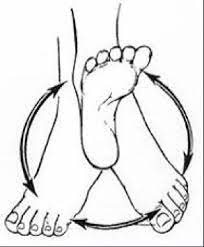
Ice bottle massage exercise
- It is the best exercise for cooling down (literally). The patient would need to prepare by filling the plastic bottle with water as well as freezing this overnight.
- To round out the exercise routine:
- Tell a patient to place the frozen water bottle on the floor. After that, roll the foot over this for one to two minutes three times per day.
- Always keep the foot moving, but do not stop & let the bottle rest on a single spot. If a cold causes discomfort, a patient can place the kitchen towel between the bottle and the foot as well. If there is pain or even a prickly sensation, stop as well as avoid this exercise.
Flexors strengthening with a theraband
- To begin with, the therapist should tell the patient to sit on the chair as well as tie the band around a stable surface that would not move, such as a heavy table. Extend the lower leg as well as wrap the other end of the theraband around the top of the foot.
- Do flexion of the foot, with the band resisting the movement. Hold for 10 seconds. Repeat ten times in one session. Do two sessions in a day for strengthening. After 5 to 6 days increase the weight from 500 gm to 1 kg & increase repetitions.

Extensors strengthening with the band
- To start with, tell a patient to sit on the chair. After that, take one side of the band in each hand, & wrap this around a ball of the injured foot, & stretch the leg out in front of you. Next, extend the foot away from the face. Hold the position for the next 10 seconds. Repeat 10 times per session. Do three sessions in a day.
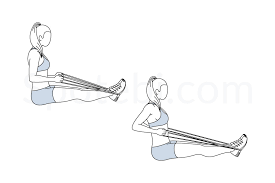
Inversor strengthening with theraband
- To embark with, tie the theraband around the leg of the chair or with a table on the same side of the injured foot. Next, wrap the other end of the theraband around the inside of the affected foot.
- After that, try to turn the foot inside. Hold the position for the next ten seconds. Do this exercise 10 times per session. Do two sessions in a day. When a patient is adapted to the 500gm weight, increase the weight to 1 kg as well as increase the repetitions.

Eversors strengthening exercise with the use of the band
- To start with, tie a theraband on the leg of the chair opposite to the affected foot. After that, wrap the other end around the outside of the affected foot. Next, the physical therapist should give the command to a patient that tries to turn the foot outside, & hold for ten seconds, and repeat the exercise 10 times per session.
- Do two sessions and three sets per day. When a patient is adapted to the 500gm weight, increase the weight to 1kg as well as increase the repetitions.
Step-ups
- To embark with, the affected foot on the bottom stair and the good foot on the floor. Straighten the knee so he/she can lift yourself up on the affected leg, then put it down. Repeat this exercise ten times in one session, minimally 3 sessions and three set a day.
- When the patient is comfortable with the low repetitions, then increase the number of repetitions.

FAQ
Can the patient train the muscles in the feet?
Doing toe curls builds up the flexor muscles of the toes & feet, improving overall strength. To do this exercise: Sit up straight in the chair, with your feet flat on the ground. Lay a small towel on the ground in front of the body, with the short side facing the feet.
Strengthen the Soles
Stand with the feet together. Step back with the left leg, keeping the toes on the ground & raising the heel. The patient will feel the stretch to the muscles in the soles of his feet, so hold this for 20 seconds. Come back to standing and repeat on the right-hand side, stretching both sides 5-10 times.
The most common cause of foot drop is compression of a nerve in the leg that controls the muscles involved in lifting the foot (peroneal nerve). It nerve can also be injured during hip or knee replacement surgery, which may cause foot drop.
This can stem from diabetic neuropathy, tarsal tunnel syndrome, Charcot-Marie-Tooth disease, multiple sclerosis, muscular dystrophy, and other disorders or diseases that affect your muscles and nerves.
Foot fatigue is a common condition that happens after the patient stand or walks for long periods of time. The foot muscles become overly tired & cramp, causing the sufferer to experience pain and begin to limp.
The posterior leg muscles that insert on the foot are the: gastrocnemius, plantaris, soleus, tibialis posterior, flexor digitorum longus, & flexor hallucis longus.


